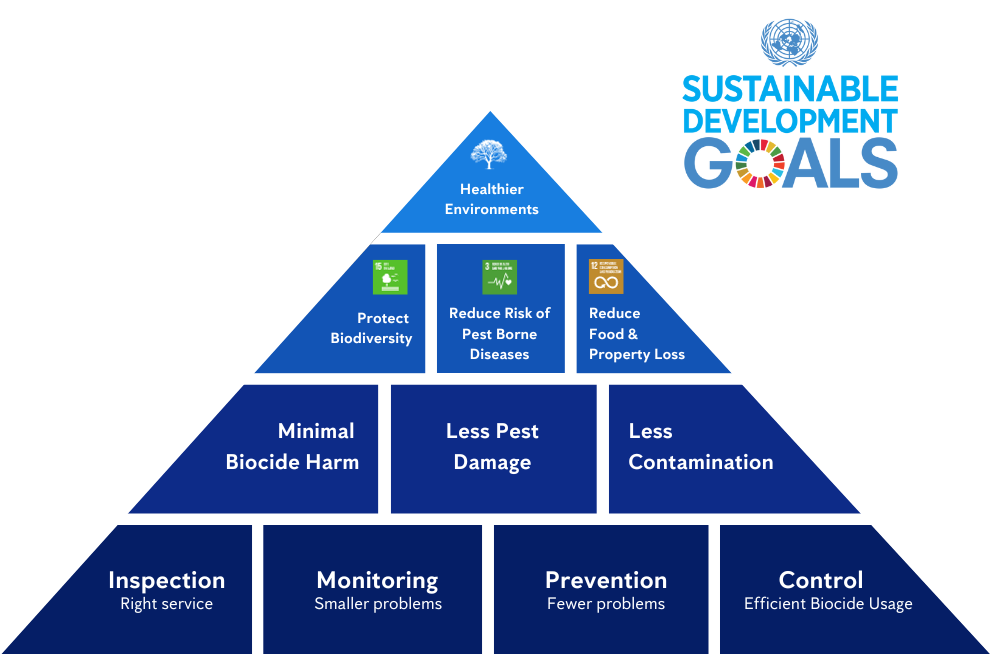Blog Article
Stricter Legislation Demands a New Approach
Pest control is evolving to become more proactive and less reliant on chemicals due to increasingly strict legislation. While the widespread use of pesticides was once common, regulations today have significantly limited chemical use in public spaces, agriculture, natural areas, and other sensitive environments.
Implementing a comprehensive Integrated Pest Management (IPM) plan enables your business to meet sustainability goals while confidently navigating audits, standards, and regulations—ensuring full compliance every step of the way.
> More about minimum regulatory requirements & commercial standards in the food processing industry

Anticimex Methodology and Our Sustainability Impact Areas
Implementing sustainable pest management practices in the food industry aligns with environmental stewardship, promotes human health and safety, ensures regulatory compliance, strengthens brand reputation, and delivers long-term economic benefits for businesses.
At Anticimex, we take corporate responsibility seriously, continuously improving our processes and products to be more sustainable and humane. We focus on 3 impact areas:
- Preventing the spread of pest-borne diseases
- Reducing property loss and food waste
- Minimizing the use of biocides, rodenticides, and insecticides
By leveraging Anticimex SMART—our digital monitoring and control system—and the data available through our online customer portal, we help reduce CO2 emissions (fewer technician visits), minimize paper waste, and protect biodiversity. Our approach uses fewer biocides, avoids secondary poisoning, and ultimately reduces our environmental impact.
Inspection: Inventarisation and Evaluation
Starting an Integrated Pest Management (IPM) program begins with a thorough "baseline measurement," allowing efforts to be assessed against an initial reference point. This involves inspecting the premises for pest activity, risk areas, entry points, potential hazards, missing protocols, and other factors that could impact pest management.
During the inspection, it is essential to review historical data, previous reports, past inspection actions, documentation, compliance with commercial standards, and other relevant events.
Using this information, we create a tailored IPM program designed to meet your specific needs. The program's effectiveness is evaluated annually through trend analysis and our advanced SMART data system, ensuring continuous improvement and optimal results.
Common Pests in the Food Industry and Their Risks
Stored Product Insects (SPIs), cockroaches, and flies are among the most prevalent insects in the food industry. These pests spread diseases such as typhoid and cholera through their excrement, contaminated legs, saliva, and hair. Beetle larvae consume stored supplies, and their webbing and droppings degrade product quality, often rendering it unusable.
Rodents, including mice and rats, also present a significant threat. Their feces and urine carry harmful bacteria such as Salmonella and the plague pathogen. In addition to contaminating food, rodents cause damage by gnawing on food products, packaging, and electrical wiring, further compromising facility safety and operations.
Digital Monitoring and Real-Time Data
When pests infiltrate a facility, it’s essential to confirm their presence and assess the threat before implementing effective control measures.
Traditional pest control methods typically rely on monthly, quarterly, or annual inspections. However, the integration of intelligent digital monitoring systems has transformed pest management, particularly in food processing environments.
Anticimex SMART utilizes intelligent traps, sensors, and cameras to monitor pest activity and temperature changes around the clock. These devices are strategically placed in hard-to-reach areas and low-traffic zones throughout the facility.
The SMART system continuously sends data to a SMART Hub and our customer portal, enabling real-time monitoring. This allows for rapid pest detection and targeted responses, as well as providing comprehensive documentation to meet audit and compliance requirements.
Practical Prevention Tips
- Seal holes in walls and cracks under doors to prevent mice and crawling insects from entering.
- Consider the placement of plants near open windows and doors, as they can attract pests and provide easy access or hiding spots.
- Implement a robust cleaning, sanitation, and food safety protocol to minimize risks.
- Remove crumbs and food waste promptly, and ensure that all incoming goods are thoroughly inspected for pests.
Learn more on how to prevent pest infestations at your food processing facility.
Risk Analysis to Determine the Type of Pest Control
The use of chemicals should only be considered as a last resort when all other pest control measures have failed. This process begins with a thorough risk analysis, taking into account:
- The type of pest
- The process and environment
- Commercial standards and thresholds
- The potential impact of biocides
Key questions to address include:
- How could the pest spread germs or contaminate the product?
- What are the potential risks of contamination when using pest control products?
- Could there be primary or secondary poisoning of non-target species?
A careful evaluation ensures that pest control methods are effective while minimizing risks to people, products, and the environment. Stay compliant with regulations by making informed, responsible choices.
Big Data Enhances Your Pest Management Efforts
At Anticimex, we leverage data to improve pest prevention and control. By analyzing pest activity over time, we gain insights into current infestations while also forecasting potential future issues, enabling more efficient and proactive action.
Trend Analysis
Trend analysis examines historical data to uncover patterns, tendencies, and shifts in pest dynamics over specific periods. By understanding these trends and past behaviors, businesses can anticipate potential pest threats and implement targeted preventive measures before problems arise.
This proactive approach reduces the risk of infestations and builds a robust pest management strategy. Recognizing recurring patterns allows businesses to optimize resource allocation, streamline operations, and enhance the overall efficiency of their pest control programs. The result is not only cost savings but also more sustainable pest management practices.

